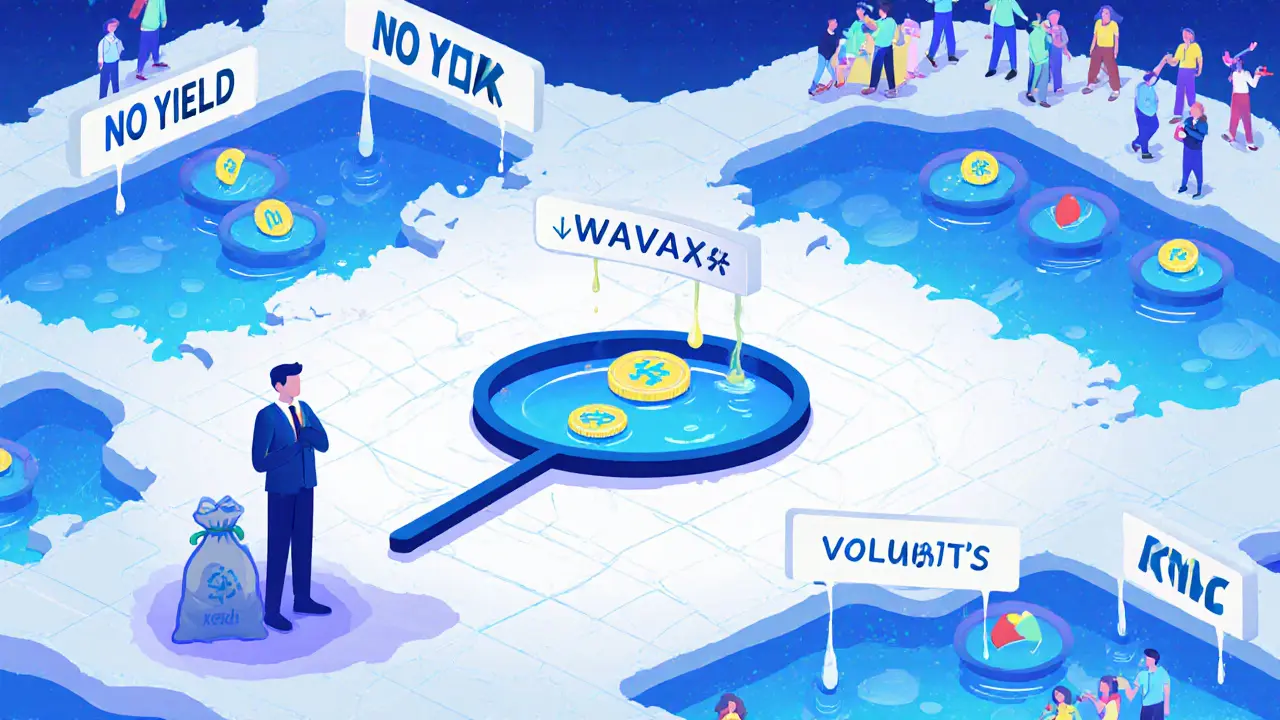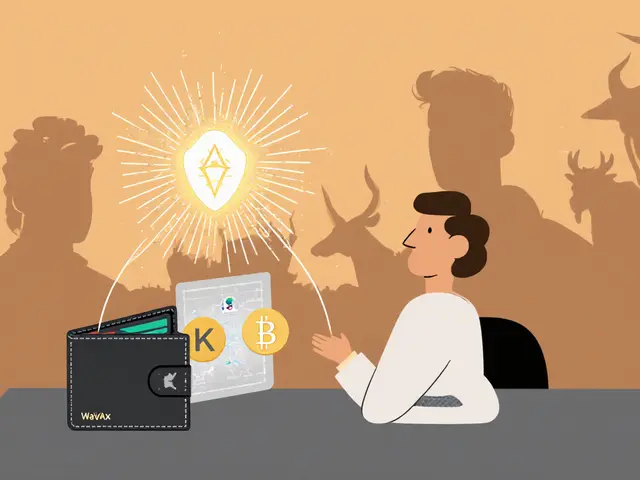KyberSwap Classic (Avalanche) Trading Calculator
How This Calculator Works
Based on data from the article, KyberSwap Classic (Avalanche) has an average bid-ask spread of 0.68%. This calculator estimates your trading costs using that spread. Note: Actual costs may vary based on market conditions.
Important Notes
This calculator uses the average 0.68% bid-ask spread reported in the article. Actual costs may vary due to market conditions and liquidity. Remember that KyberSwap Classic (Avalanche) has no public audits and very low trading volume ($4,830 daily), which could impact your trade.
Only swap small amounts if you're testing the platform, as there's no security audit or user review history. This is a niche tool for specific use cases like trading KNC to WAVAX directly on Avalanche.
When you're trading crypto on Avalanche, you want speed, low fees, and real control over your money. KyberSwap Classic (Avalanche) promises all three-but does it deliver? This isn't a big-name exchange like Binance or Coinbase. It doesn't have hundreds of coins or millions in daily volume. But if you're looking for a simple, non-custodial way to swap tokens directly on Avalanche, it might be worth a closer look.
What Is KyberSwap Classic (Avalanche)?
KyberSwap Classic (Avalanche) is a decentralized exchange aggregator built specifically for the Avalanche blockchain. It doesn't hold your funds. You connect your wallet-MetaMask, Phantom, or any EVM-compatible one-and trade directly from your account. That’s the whole point: no KYC, no deposits, no middleman. Your keys, your coins.
It’s part of the larger KyberSwap network, which launched in 2018 and was one of the first dynamic market makers in DeFi. But unlike the multi-chain version that pulls liquidity from Ethereum, Polygon, and Arbitrum, the Avalanche version is narrow. It only supports two tokens: WAVAX and KNC. That gives you four trading pairs: WAVAX/KNC, KNC/WAVAX, and two stablecoin variants (likely USDT/WAVAX and USDC/WAVAX, though not officially confirmed).
The daily trading volume? Around $4,830. That’s tiny compared to the billions moving on major DEXs. But volume isn’t everything. On Avalanche, where transactions cost pennies and confirm in under a second, even small volumes can mean smooth trades if liquidity is well-distributed.
How It Works: Simple, But Limited
Using KyberSwap Classic (Avalanche) is straightforward. You open the website, connect your wallet, pick your tokens, and click swap. The platform scans multiple liquidity pools on Avalanche-like Pangolin, TraderJoe, and its own reserves-to find the best price. It doesn’t just pick the first one it sees. It calculates slippage, fees, and output across sources to give you the most efficient route.
That’s the aggregator advantage. On a single DEX, you might get 100 KNC for 1 WAVAX. On KyberSwap, it might find a better rate: 102 KNC. That 2% difference matters when you’re trading larger amounts.
The bid-ask spread averages 0.68%. That’s decent for a small DEX. On centralized exchanges, spreads are often below 0.1%, but those platforms hold your money. On DeFi, 0.68% is acceptable-especially when you’re avoiding identity checks and withdrawal delays.
Why It’s Not for Everyone
If you want to trade SOL, ETH, or even AVAX itself, you’re out of luck. KyberSwap Classic (Avalanche) only supports WAVAX and KNC. WAVAX is wrapped AVAX, so you can swap between AVAX and WAVAX on other platforms first. But if you’re looking to swap, say, USDC for DAI on Avalanche, this isn’t the place. You’d be better off using TraderJoe or Pangolin.
The lack of asset variety isn’t a bug-it’s a design choice. KyberSwap Classic (Avalanche) seems to be a niche tool, likely meant for users who hold KNC (Kyber’s native token) and want to trade it for WAVAX without leaving the Avalanche network. It’s not built for broad DeFi activity.
There are no user reviews. Zero. No ratings, no Reddit threads, no Twitter complaints. That’s unusual. Even obscure DEXs get some chatter. The silence suggests either very low usage or a lack of community awareness. It’s hard to trust something when nobody’s talking about their experience.

Security and Regulation: No Safety Net
KyberSwap Classic (Avalanche) is unregulated. There’s no FDIC insurance, no customer support team, no chargeback option. If you send funds to the wrong address, or if a smart contract bug freezes your trade, you’re on your own. That’s standard for DeFi-but it still carries risk.
The platform is non-custodial, which is good. But the smart contracts? They’ve never been audited publicly. No CertiK, no SlowMist, no PeckShield reports are available. That’s a red flag. Even small DEXs usually publish audits to build trust. Without one, you’re trusting code that’s invisible to outsiders.
Compare that to TraderJoe, which has had multiple audits and a $200M+ TVL. Or Pangolin, which has been live since 2020 with clear documentation. KyberSwap Classic (Avalanche) doesn’t offer that kind of transparency.
Who Should Use It?
You should consider KyberSwap Classic (Avalanche) if:
- You hold KNC and want to swap it for WAVAX on Avalanche
- You’re testing DeFi tools and want to experiment with a minimal interface
- You prefer non-custodial swaps and don’t mind limited options
You should avoid it if:
- You need to trade more than two tokens
- You want to see user feedback before committing
- You’re trading large amounts and need proven liquidity
If you’re just starting on Avalanche, stick with TraderJoe or Pangolin. They have more coins, higher volume, and active communities. KyberSwap Classic (Avalanche) feels like a side project-not a primary tool.

Yield Farming? Not Really
KyberSwap’s main platform offers yield farming. But on Avalanche? There’s no public pool data. No TVL stats. No APR estimates. You can’t even find a link to a liquidity pool page. That’s a big gap. If you’re looking to earn by providing liquidity, this version doesn’t offer it-or at least, not in any visible way.
On other chains, KyberSwap lets you deposit tokens into pools and earn trading fees plus KNC rewards. But on Avalanche? Nothing. That makes this version even less appealing for active DeFi users.
How It Compares to Other Avalanche DEXs
| Feature | KyberSwap Classic (Avalanche) | TraderJoe | Pangolin |
|---|---|---|---|
| Supported Tokens | 2 (WAVAX, KNC) | Over 1,000 | Over 800 |
| Daily Volume | $4,830 | $45M+ | $20M+ |
| Slippage Optimization | Yes | Yes | Yes |
| Non-Custodial | Yes | Yes | Yes |
| KYC Required | No | No | No |
| Liquidity Pools | Not available | Yes | Yes |
| Audits | None public | Multiple | Multiple |
| User Reviews | 0 | Thousands | Thousands |
TraderJoe and Pangolin dominate Avalanche DeFi. They’re faster, deeper, and safer. KyberSwap Classic (Avalanche) doesn’t compete-it coexists. It’s a quiet corner of the ecosystem, used by maybe a few hundred people a day.
Final Verdict: Niche, Not Essential
KyberSwap Classic (Avalanche) isn’t broken. It works. If you have KNC and WAVAX and want to swap them, it’ll do the job. The interface is clean. The trades execute quickly. The fees are low.
But it’s not a go-to exchange. It’s a specialty tool. A curiosity. A placeholder. Without audits, without reviews, without liquidity pools, and without more than two tokens, it doesn’t offer enough value to justify choosing it over the alternatives.
Use it if you’re experimenting. Use it if you’re holding KNC and need a quick swap. But don’t rely on it. Don’t deposit large amounts. Don’t treat it like a primary DEX. For everything else-stick with TraderJoe. It’s where the real action is on Avalanche.
Is KyberSwap Classic (Avalanche) safe to use?
It’s non-custodial, so your funds aren’t held by a third party. But there are no public smart contract audits, and the platform has zero user reviews. That means you’re trusting code that hasn’t been independently verified. Use small amounts only.
Can I trade AVAX on KyberSwap Classic (Avalanche)?
Not directly. It only supports WAVAX, which is wrapped AVAX. You can swap AVAX to WAVAX on other platforms like TraderJoe first, then use KyberSwap to trade WAVAX for KNC.
Why is the trading volume so low?
Because it only supports two tokens and lacks liquidity pools. Most traders on Avalanche use platforms with hundreds of tokens and deeper pools. KyberSwap Classic (Avalanche) serves a very narrow use case.
Does KyberSwap Classic (Avalanche) have a mobile app?
No. It’s a web-based platform only. You access it through your browser by connecting your wallet. There’s no official iOS or Android app.
Can I earn interest by adding liquidity?
There’s no evidence of liquidity pools or yield farming on the Avalanche version. While the main KyberSwap platform offers this feature, it hasn’t been implemented-or made public-on the Avalanche-specific version.
How does it compare to 1inch or Paraswap?
1inch and Paraswap work across multiple chains, including Ethereum and Polygon. KyberSwap Classic (Avalanche) is limited to Avalanche only. If you’re trading on other networks, those aggregators are far more powerful. But if you’re only on Avalanche, TraderJoe and Pangolin are better choices.
Is KyberSwap Classic (Avalanche) still being updated?
There’s no public roadmap or recent update logs for this version. The broader KyberSwap platform is active, but the Avalanche-specific deployment appears stagnant. Without updates, security risks could grow over time.


Laura Hall
So you're telling me this thing only does WAVAX and KNC? Like, what even is the point? I could do that on TraderJoe in 3 seconds and get better rates. This feels like someone threw a DEX together during a lunch break and forgot to add more tokens.
Arthur Crone
Zero audits and $4k volume? This isn't a DEX it's a graveyard. If you're using this you're either a lab rat or you're already broke. Either way stop wasting everyone's time.
Rebecca Saffle
I don't care how cheap the gas is if the contract could vanish tomorrow. No audits means no trust. No reviews means no proof anyone even tried it. This isn't DeFi it's a gamble with your private keys.
Adrian Bailey
Okay so I tried this thing out of curiosity because I had some KNC sitting around and honestly it worked? Like the UI was clean and the swap went through in like 2 seconds. The volume is tiny but maybe that's because nobody knows it exists? I mean TraderJoe is way better for everything else but if you just need to dump KNC for WAVAX and you're already on Avalanche? It's not the worst thing ever. I wouldn't put a grand in it but for like $20? Fine. Also I think it might be a side project by the Kyber team to test something, not meant to be big. Just saying.
Rachel Everson
For beginners on Avalanche, definitely stick with TraderJoe or Pangolin. But if you're holding KNC and want to swap it without leaving the chain, this is actually the only option. It's not for everyone, but it's not useless. Just use small amounts and don't treat it like your main exchange. And yeah, audits would be nice but at least it's non-custodial. That's more than some platforms can say.
Johanna Lesmayoux lamare
Works for its niche. Nothing more.
ty ty
Wow a DEX that only does two tokens. Did the devs run out of coffee? Or maybe they're just trying to make a point that most DeFi is useless. Congrats you built the world's smallest exchange. Now go cry in a corner.
tom west
The lack of public smart contract audits on a financial protocol is indefensible. The absence of liquidity pools renders the platform functionally obsolete for any serious DeFi participant. The trading volume is statistically irrelevant. The user engagement metrics are non-existent. This is not an innovation. It is a technical artifact with no economic utility. The only plausible explanation is that it was deployed as a placeholder for a failed initiative. Do not interact with this contract under any circumstances.
dhirendra pratap singh
Bro this is why crypto is dying. People building useless shit like this and calling it DeFi. I tried it once and my wallet got stuck for 10 mins. No support. No help. Just silence. And now you're writing a whole review like it's something special? LMAO. You're part of the problem.
Ashley Mona
Honestly I think this is kind of cute? Like a little crypto underdog. It’s not flashy, it doesn’t have a million coins, but it does one thing simple and clean. I’ve used it twice to swap KNC for WAVAX when I was testing a new wallet setup. No drama, no errors, just worked. And hey, maybe it’s a quiet experiment that’ll grow? Who knows? But if you’re not trying to move $10k in a day, it’s chill. Just don’t cry when you can’t swap your Shiba Inu coin.
Edward Phuakwatana
This is a perfect example of composability in action. KyberSwap Classic on Avalanche isn't trying to be a liquidity hub - it's a specialized atomic swap module optimized for KNC/WAVAX pair arbitrage within a hyper-efficient EVM environment. The low volume? That's because it's designed for micro-liquidity providers and token-holding insiders, not retail degens chasing meme coins. The absence of yield farming? That's intentional - it avoids diluting the incentive structure of the mainnet. The lack of audits? Probably because the contract is so minimal it doesn't need them. Think of it as the Swiss Army knife of token swaps: no frills, no fluff, just pure on-chain mechanics. If you're building a DeFi stack that requires precise, low-slippage, non-custodial KNC exits, this is the quiet engine you didn't know you needed.
Suhail Kashmiri
People still using this? Bro you know this is like using a typewriter in 2024 right? Why not just use TraderJoe? You're wasting your time. Also why do you even have KNC? Who even holds that?
Kristin LeGard
So let me get this straight - we're supposed to trust a platform that doesn't even let you trade AVAX? And no audits? And no reviews? This isn't crypto, this is a scam waiting to happen. If you're not in the US, you're lucky you're not getting your funds stolen. This is why Americans are scared of DeFi - because of idiots building this garbage.
Arthur Coddington
It’s funny how we romanticize these tiny tools. Like, oh look, it’s so minimalist! So pure! But it’s not purity - it’s neglect. No audits, no users, no future. It’s a ghost DEX. A digital ghost town. I bet the devs moved on to NFT art of cats wearing hats. This isn’t innovation. It’s abandonment.
Phil Bradley
Honestly I think it’s kind of refreshing? Like, not every platform needs to be a giant monster with 1000 tokens and a team of 50 devs. Sometimes you just need a quiet corner where you can swap two things fast and cheap. It’s not going to replace TraderJoe, but maybe it’s there for the people who just need to move KNC and don’t want to deal with the noise. Kinda like a little crypto zen garden. 🌿